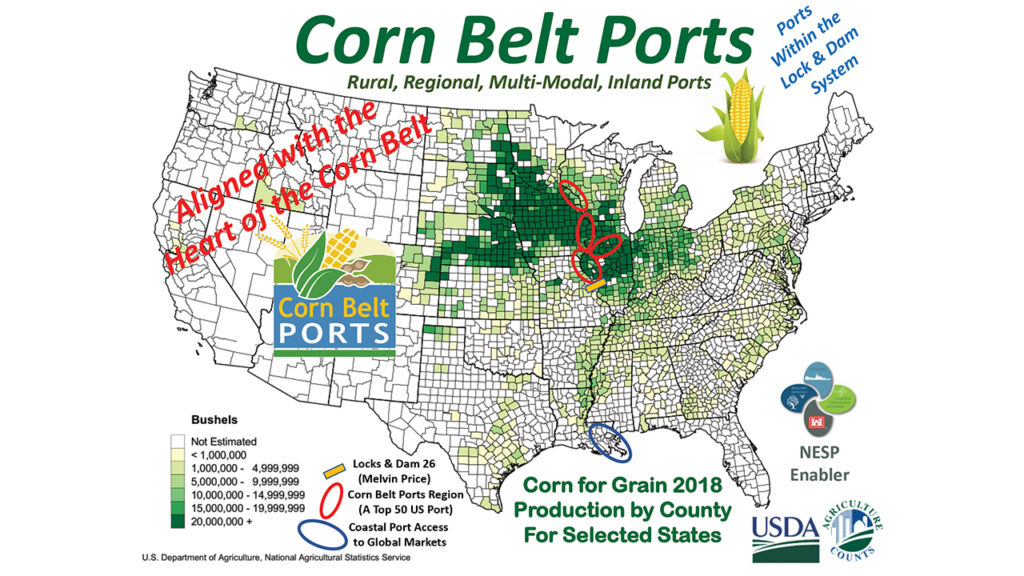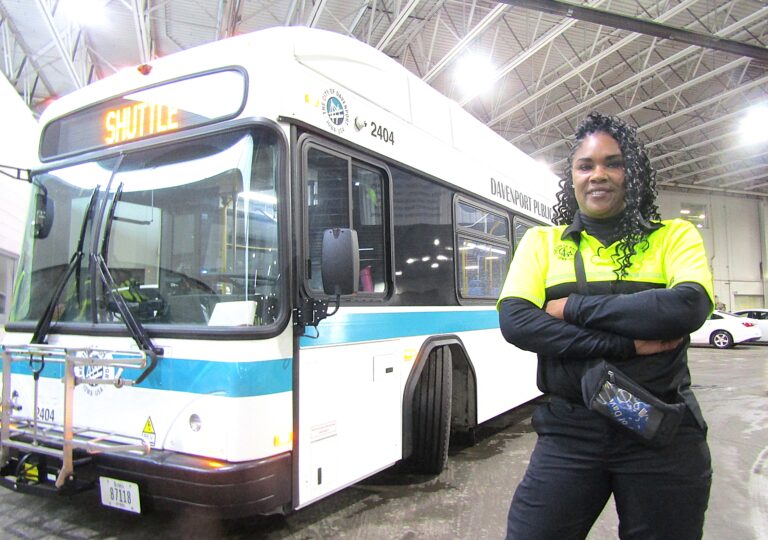Since the Corn Belt Ports was launched to attract federal investment to the upper Mississippi River and Illinois Waterways, the region has celebrated $2 billion in infrastructure funding and is working to capture $500 million more over the next two years.
Today, Corn Belt Port leaders also are working with local and regional partners to help create a system of local port districts to help leverage grants and other investment within the four Corn Belt Port regions. Those regional ports, which are each 200 miles long and handle about 50 million tons of cargo, are:
- Mid-America Port Commission in Illinois, Iowa and Missouri.
- Upper Mississippi River Ports in Illinois and Iowa, which includes the Quad Cities.
- Illinois Waterway Ports in central and north-central Illinois.
- Northern Grain Belt Ports in Wisconsin and Minnesota.
The successful campaign to create those ports and get them recognized by federal authorities was captained by the indefatigable former U.S. Army Corps of Engineers commander and retired colonel Bob Sinkler.
Spurring the effort along, Mr. Sinkler, currently the coordinating director of Corn Belt Ports, told the QCBJ was the region’s enthusiasm for creating the port system. For example, it took just 90 days to get resolutions of support passed by all 15 counties impacted by the regional effort launched in 2019, he said.
Just one year later, the previously nonexistent Corn Belt Ports region was nationally listed and ranked 56th among U.S. ports. The initial goal had been to hit the top 100. Today, Mr. Sinkler said, “We think a top 50 port is really within the realm of possibilities.”
Before Corn Belt Ports was included by the federal government as part of Marine Highway 35, there was a major gap in that official map of Mississippi River ports between St. Louis and Minneapolis.
That’s important, Mr. Sinkler said, because that river chart is used by Washington to allocate federal dollars. It’s also, in part, why there had been no federal investment except routine maintenance in that large region for decades.
“Everyone knew we had waterways here, but they didn’t recognize that we had ports, so we really had to marry both of them together and maximize the amount of investment coming in,” Mr. Sinkler said. Creating the Corn Belt Ports regions also helped “organize this crazy mess that we have out there.”
That complex network includes port statistical areas, port districts, port authorities, port and economic development organizations, private terminals, public docks, harbors and joint harbors. “We were confusing ourselves, and we were definitely confusing the national level on how we were organized,” he said.
Cutting through that confusion is one of the reasons that the creation of a network of local port districts throughout the Corn Belt Region has been a priority of that organization and the river communities within it.
Rock Island leads way
Among them is the new Rock Island Regional Port District now under development. It encompasses: the city-owned Rock Island Marine Port Terminal, operated by Alter Logistics Company; Sunset Business Park, which serves some 20 businesses; and the rest of the city.
Bi-State Regional Commission Deputy Director Gena McCullough said Bi-State worked with Rock Island Mayor Mike Thoms to write the legislation that created it. The planning agency also worked with state lawmakers and staff to rewrite the bill to enable the Rock Island City Council to run the district. Importantly, too, the enabling legislation allows adjacent cities such as Moline and Milan to join the regional district if they choose to do so, Ms. McCullough said.
During the first annual Corn Belt Ports meeting, held in October at the Western Illinois University campus in Moline, Mr. Thoms credited Corn Belt Ports leaders – Chris Smith, director of operations; Anshu Singh, sustainability & conservation director; and Mr. Sinkler – for creating the Corn Belt Ports and supporting new local districts.
“Bob Sinkler has been a driving force, not just in this area, but up and down the Mississippi River and Illinois River to make these things happen,” the mayor said.
“He’s been very persistent. He doesn’t let anything just sit still, that’s for sure. If I got one email, I got 100 emails just to push this thing along,” he said.
Mr. Thoms also applauded the new Upper Mississippi River Ports of Eastern Iowa and Western Illinois. It will serve Clinton, Dubuque, Jackson, Louisa, Muscatine and Scott counties, and will operate within the Mississippi River Ports of Eastern Iowa and Western Illinois.
Ryan Sempf, the Quad Cities Chamber’s executive director of government affairs, called the Ports of Eastern Iowa Authority ”a significant milestone for our region and reflects the vital role that the Mississippi River Ports of Eastern Iowa and Western Illinois play in both our national defense and our economy.”
Mr. Thoms said progress so far is “just the beginning of a lot of great things to happen.” For Rock Island that includes $368,000 in Illinois Department of Transportation Statewide Planning and Research grants to develop a master plan for the fledgling Rock Island Regional Port District.
Thomas Flaherty, assistant to the city manager and economic development director for Rock Island, said the city expects to seek requests for qualifications in the next few weeks for an expert consultant to write a comprehensive long-range plan to guide the district’s future.
“We have to get that master plan going before we can really understand what we’re going to do next,” he added. “The master plan is going to tell us how we want to put this thing together over the next 18 to 20 years.”
Road map for development
Bi-State’s Executive Director Denise Bulat told the QCBJ that the Rock Island port master plan will help the city determine what to do to revitalize and redevelop the business park in tandem with the city terminal operated by Alter Logistics.
“The hope is that the plan actually tees them up for money,” Ms. Bulat added. “That’s the bottom line and it could be federal money or actual port infrastructure for the terminal (the city) owns.”
Port District money won’t only be destined for projects that are “right on the river,” Mr. Thoms added. “It is for streets, roads, highways, rails, etc. that may help access to ports and multi-modal type of operations.”
It also could include workforce training and flood protection such as automating the city’s floodgates to make commercial and industrial areas safer, more robust and more resilient, Ms. McCullough added.
Quad Chamber of Commerce CEO Peter Tokar III applauded the local port efforts.
“The creation of the Rock Island Regional Port Authority and Ports of Eastern Iowa build the necessary foundation to pursue federal funding to support our role as a multi-modal transportation hub,” he told the QCBJ. “With these new entities, we have an opportunity to further define our region as a great place to do business in a global marketplace.”
Mr. Tokar added “Improving our multimodal infrastructure is necessary to attracting investment to the region. The newly designated port authorities create a place for that investment to flow through.”
The ability to attract investment to the Corn Belts Ports region is also what Mr. Sinkler and others sought to do so by creating the regional system.
“We were a big black hole on the U.S. ports map and that supports decision making in D.C. so that really was just hard for our elected officials to be able to articulate the value of investing in port infrastructure in our region when we didn’t have ports,” Mr. Sinkler said.
Riverdale, Iowa, Mayor Anthony Heddlesten, whose day job is deputy design branch manager of the U.S. The Army Corps of Engineers, is well acquainted with the infrastructure, navigation and environmental investments federal designation can bring.
Today, after years without any new federal funding for new projects, a new mooring cell is being built on the upper Mississippi River in the Quad Cities to help tow boats and barges move more efficiently through Lock and Dam 14. The Corps of Engineers facilities in Pleasant Valley also just had a major multi-million facilities upgrade, and Mr. Heddlesten said the Lindsay Park Yacht Club in Davenport received funding for the first time in many years for dredging.
In addition to the regional impact, the work of the Corn Belt Ports regions also has a global impact, Paul Matthews, CEO of the Port of South Louisiana, told the QCBJ in a phone interview.
“Any time you have an opportunity to form a port, a collaborative transportation region on the Mississippi River and its tributaries, it’s very critical,” he said.
Region has global impact
Some 70% of the nation’s grain is exported from the lower Mississippi River and its five ports that includes South Louisiana. About 25% of the petrochemical products exported out of the U.S. come down by the same route, Mr. Matthews said. It gets there by way of the cities and states that are connected to the Mississippi River in Arkansas, Tennessee, Illinois, Iowa and Minnesota.
His port sees more than 240 million tons of cargo and half of that is grain that is then exported out of the U.S. market.
In addition to products going to Mexico, other parts of Central America, South America, Colombia, Japan, China and the Netherlands, there is volatile conflict between Russia and Ukraine which had been two of the top five exporters of grain in the world.
That makes investment in the Quad Cities and the Upper Mississippi River infrastructure even more important, Mr. Matthews said, adding “we recognize that connectivity with infrastructure is going to make us more competitive for our farmers to be in a better position to sell their grain to the world.”
He added: “We can work together in a bipartisan manner to push the idea of making sure that infrastructure projects are properly funded.”
Bi-State’s Ms. McCullough said there is strength in numbers when seeking government infrastructure and other investment. “There really is a lot of volume moving on the Mississippi River, but because it’s all of these small terminals that are doing the work and it’s not one single port, it kind of falls to the wayside,” she told the QCBJ. “There is more voice when everyone comes together and I think that’s part of what this is trying to accomplish, too.”
Today, the amount of freight making its way throughout the Upper Mississippi River from the northern border of Iowa down to the southern one is much easier to track thanks to a frequently updated Bi-State Freight Planning page on the planning commission’s website. The tracker also helps to bring more attention to the importance of the Quad Cities regional and local port districts.
Mr. Sinkler said the ports and their resources also “help the Quad Cities region be seen and recognized as a nationally and globally significant multi-modal transportation logistics center.”
For corporations that are part of the supply chain and rely on the supply chain, he said this “just benefits them and it benefits our economic development initiatives and it’s just easier to tell the story of the multimodal transportation logistics center that we really are by having a port here that’s recognized by the U.S. government.”
The Corn Belt Ports system also “aligns perfectly with our defense, manufacturing and logistics corridor that we have here,” Mr. Sinkler said. That includes the Rock Island Arsenal, the Joint Manufacturing & Technology Center and some 150 defense contractors.
Then there is the positive environmental impact from investing in barges, ports, wetlands and other areas. “We really are a good news story in reducing carbons and the wetlands themselves along the flood plains are natural carbon sinks,” Mr. Sinkler said.
How can Quad Citians help the regional and local ports in those efforts?
“Everyone needs to identify as being part of a port or as supporting their home port,” Mr. Sinkler said. “There is a home port advantage and just being designated as a port or having our companies identify with a port, the more visibility we have for the region.”
CORN BELT PORTS – AT A GLANCE
The Corn Belt Ports are the federally recognized ports in the heart of the Corn Belt above Locks and Dam 26 on the Upper Mississippi River and Illinois Waterway. The four regional Corn Belt Ports within the Corn Belt’s Lock and Dam System are:
- Mid-America Port Commission in Illinois, Iowa and Missouri.
- Upper Mississippi River Ports in Illinois and Iowa, which includes the Quad Cities area.
- Illinois Waterway Ports in central and north-central Illinois.
- Northern Grain Belt Ports in Wisconsin and Minnesota.








